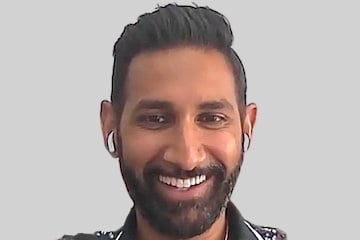How to Survive a Million-Dollar Loss

This year I’ve sprinkled occasional “Ecommerce Conversations” episodes with real-life master classes from Beardbrand, my company. To date I’ve addressed hiring, branding, profit-building, priority-setting, and exiting.
For this installment, I’ll share Beardbrand’s experience of losing nearly $1 million across 2023 and 2024. I’ll recap how we managed to survive our worst years in business while remaining 100% bootstrapped.
It got bad. Our cash levels dropped to where they were in year one, 2014. We were hemorrhaging money.
But we’re still here — still building and still learning. We made it through without outside funding.
Here’s what the future holds for Beardbrand. My entire audio dialog is embedded below. The transcript is condensed and edited for clarity.
Ghosted
A big portion of our loss came from Target. The company had been a seven-figure account for us for years, and we thought the relationship was solid. Every year, we pitched Target our plans. Historically, the staff there provided us with clear feedback — what worked, what didn’t, and where there was room for growth.
In 2023, Target had a sustainability initiative. We revamped our packaging, switching from glass and plastic to aluminum. It’s lighter, more recyclable, and aligns with eco-conscious goals. At the same time, we increased the size of our beard oil packaging from 1 oz. bottles to occupy more shelf space and stand out.
We committed early, produced inventory, and delivered Target’s purchase orders on time. Then silence. Nothing. After years of working with us, the staff ghosted us. No feedback, no responses. Worse, they dropped us and left us with nearly $200,000 of unpaid product.
We erred by giving Target exclusivity, which meant we weren’t selling on Amazon or Walmart. That killed our ability to move leftover inventory quickly when they dropped us. By the time we finally got on Amazon, the products had already aged out. We destroyed a large quantity that had expired.
Reserves
We’ve always run Beardbrand conservatively. That means keeping a decent amount of capital in reserve — not because we’re paranoid, but because you never know when a black swan event might hit. Having that runway lets you make clear, intentional decisions rather than panicking. It gives you time to explore solutions, test channels, and get a better night’s sleep.
Thankfully, during our stronger years, we built up a solid cushion. And that cushion is what kept us afloat during the downturn. We essentially burned through all of it. But we never dipped below zero, which meant we didn’t have to take out high-interest loans, open lines of credit, or bring in outside investors.
We did have conversations just in case. I even considered withdrawing money from my personal savings. But that’s a hard decision when things aren’t going well. When you’re in the middle of the storm, it doesn’t feel like a temporary dip — it feels like a freefall. You start wondering: Is this the bottom, or is there more pain ahead?
Writing another personal check to the business, especially after years of building wealth from it, was not something I wanted to do. And neither did my partners. We were determined to find a way forward that didn’t involve doubling down with personal capital or giving up control.
Pileup
In addition to losing Target, we experienced a series of setbacks. First, the state of Texas audited us. We cooperated fully, waited for the final numbers, and instead got slapped with a tax lien. That lien triggered Brex, our corporate credit card provider, to freeze our account, despite our perfect payment history. Thankfully, American Express stood by us and kept things moving.
Then came an ADA lawsuit, a leaked 100% off coupon code, and a $20,000 air conditioner repair at our barbershop. We also faced regulatory changes that forced us to reformulate key fragrances.
We had internal missteps, such as losing a key growth team member and coasting when we should’ve pushed harder. We focused on profitability, but the business slowly declined.
We simplified our product line to meet a manufacturer’s needs, which, in hindsight, proved to be a mistake. The lesson? Partner with vendors who value your business. You don’t want to be too small to matter, or too big to be managed. That relationship needs to be just right.
We also lowered prices to drive volume, but it backfired. Loyal customers just paid less, and those who thought we were expensive still did. Meanwhile, larger packaging reduced purchase frequency, and killing off beloved fragrances hurt loyalty. Top-line revenue got cut in half.
Furthermore, when your business shrinks, fixed costs such as office leases and payroll can become overwhelming. Our $10,000 per month lease that once felt small became a big deal.
Rebuilding
The good news? Beardbrand is alive. We’ve weathered the storm and slowly started turning things around. It hasn’t been a dramatic rebound — it’s been steady, slow progress. We have focused on improving operations, addressing inventory issues, resolving stock-outs, tightening pricing, and enhancing product quality.
We now have the right fulfillment provider, manufacturing partners, and systems in place. Instead of existential crises, we’re dealing with everyday stuff — shipping issues, ad performance, and the occasional bad product batch. That’s a massive shift. It’s not glamorous, but it’s no longer a matter of survival.
We cut costs aggressively — even eliminating $15 per month software. We reestablished healthy margins. Our customer service, returns, and product quality all depend on having room to breathe financially.
The Target fallout is behind us, the tax lien is resolved, and the ADA plaintiff dropped the bogus lawsuit. My business partner stepped out of day-to-day operations, and some team members transitioned to part-time roles, which helped improve our cash flow. We’ve managed all of this without layoffs. My team is the same one that helped us grow, and they’re still incredibly talented and dedicated.
I’ve also cut my own salary and lived off personal savings to keep things afloat. But I’m optimistic. With the business stabilizing, we can rebuild our savings and start exploring new growth opportunities again.
Momentum
Survival mode means focusing on making it through the day. Some entrepreneurs try to grow their way out of problems. For us, it started with stabilizing operations. We can finally think long-term again.
We’ve begun reinvesting in growth, supporting our paid media and Meta efforts, and expanding our creative team to produce more content and ads. More creative output means more chances to connect with customers and fuel a rebound.
We’re also rethinking channels beyond direct-to-consumer. Target was a strong retail partner for years. Retail as a channel still holds potential — perhaps it’s independent salons, boutique pharmacies, and grocery stores. The goal is to diversify. Beardbrand.com will always be our home base, but we’re a business that sells to people, not just an ecommerce brand.
It’s exciting to think ahead instead of looking back. We’re aiming for 7% profitability this year — that’s breakeven in my book. It provides us with a buffer for unpredictable events, such as lawsuits, audits, and air conditioning failures. The real goal is 17% profit — that’s when we can fund growth, hire employees, and breathe easier. Anything beyond that is the sweet spot where the stress and sacrifice start to feel worth it.
I’m excited again — for the team, for the future, and what we’re building.









